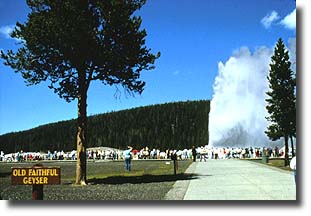

Old Faithful erupts more frequently than any of the other big geysers, although it is not the largest or most regular geyser in the park. Its average interval between eruptions is about 76 minutes, varying from 45 - 110 minutes. An eruption lasts 1 1/2 to 5 minutes, expels 3,700 - 8,400 gallons (14,000 - 32,000 liters) of boiling water, and reaches heights of 106 - 184 feet (30 - 55m). It was named for its consistent performance by members of the Washburn Expedition in 1870. Although its average interval has lengthened through the years (due to earthquakes and vandalism), Old Faithful is still as spectacular and predictable as it was a century ago.
Resource: The Official Website of Yellowstone National Park

Enter the world of nature ...
President Franklin Roosevelt issued a proclamation on August 10, 1936
establishing 825,340
acres of the California desert as the Joshua Tree National Monument, but then a
little later, in
1950, commercial mining interests were successful in removing 289,000 acres from
the
monument for the excavation of various mineral ore.
On October 31, 1994, President Clinton signed the California Desert Protection
Act, part of
which changed Joshua Tree Monument to a National Park and increased its holdings
by an
additional 243,000 acres. It also meant 'protection' for the fragile desert
ecosystem within its
boundaries, and conservationists breathed a sigh of relief.
Today, Joshua Tree National Park's more than 794,000 acres encompass six
mountain ranges
and two deserts. The two large ecosystems contained within it are primarily
determined by
elevation. The Colorado Desert occupying the eastern half of the Park is below
3,000 feet, while
the higher, wetter, and cooler Mohave Desert occupies the western portion and
varies in
elevation from 2,000 feet to almost 6,000 feet.
Quail Mountain, at 5,814 feet above sea level is the highest point within the
park, while the
lowest is the Pinto Basin at 1,200 feet. According to park records, the highest
recorded
temperature was 118 degrees in 1961, while the lowest was a cool 10 degrees in
1990. The
average rainfall, including snow, is a mere 4.06 inches per year. With such
little precipitation, the
park experiences an average of 230 clear days a year.
Approximately 80 percent of the park is designated as wilderness where “The
earth and its
community of life are untrammeled by man... where man himself is a visitor who
does not
remain.”
At present, Park staff have recorded and catalogued 673 different plants,
including 20 different
cacti, 20 species of snakes, and a variety of lizards. The endangered Desert
Tortoise also makes
its home in the park and there are more than 2,000 species of birds, many of
which make the
park their permanent home.
The mammal population is represented by the Desert Bighorn Sheep, Mountain
Lions, Bobcats,
Kit Foxes, Badgers, Coyotes, and a large variety of rodents including many
species of mice.
Park biologists concede that they cannot even guess the numbers of different
insect species to be
found there.
COPYRIGHT NOTICE Copyright © 2000 Michael Collins, All rights reserved.
Web Club would like to thank Michael Collins for giving us
permission to use his material for this page.
Resource: Virtual
29